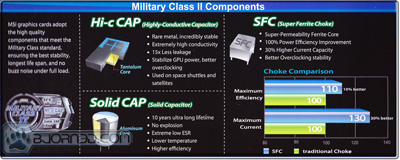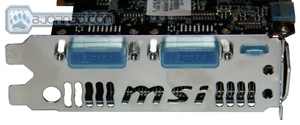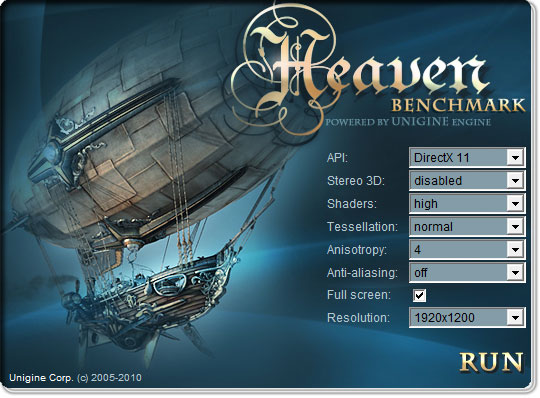The MSI GTX 560 Ti Twin Frozr II / OC delivers top performance and quality versus cost.
introduction
With the market saturated with already fine-tuned NVIDIA 460’s, buyers need a good reason to upgrade to the entry level 500 series. The MSI GTX 560 Ti Twin Frozr II / OC provides these reasons and is more than just a powerful name. One of the best cooling systems seen to date provide a solid solution in almost complete silence. Additionally, the GPU core and memory speeds come pre-overclocked from MSI right out of the box. The entry level of the MSI GTX 560 Ti is priced at $260, which is fairly value-efficient considering the stock NVIDIA 560 Ti is ten dollars less. From the line-up on the chart below, this Twin Frozr II is the first model on the chart.
(click on image for larger version)
Features & Specifications
MSI set some pretty high standards when producing the Twin Frozr II Line. Firstly, the thermal design includes dual 80mm PWM fans and a nickel-plated copper base for better heat dissipation. The SuperPipe technology entails dual 8mm copper pipes routed through a complete radiator that covers the whole card (including memory and power modules), chilling up to 20 degrees Celsius cooler than reference design. Second generation military class components have been utilized throughout the board including: Super Ferrite Chokes (SFC) that withstand higher current for better overclocking ability and Hi-C Capacitors for the GPU, providing precise voltages.
(click on image for larger version)

The chart includes the main changes between the generation in cards; the most important to note is that the CUDA core count has increased by 48. What this boils down to is a difference of 2.6 gigapixel/s fillrate, which for most, means a free bump up to the next resolution with a modest speed gain to boot.
Click Image to Enlarge
GPU-Z reveals most of what is shown in the chart above, including what types of computing formats the graphics card supports. One thing to add (which isn’t presented in the GPU-Z chart) is that the MSI card has an incredible Texture Fillrate of 56.3 GB/s — netting close to 12 extra GB/s. The GTX 560 Ti has all the features of the GTX 460 series, plus bitstreaming support for Dolby True HD and DTS-HD Master Audio over HDMI.
Pictures & Impressions
(click on image for larger version)
This Twin Frozr II series box is not only shiny, but highly informative, doing a great job of pointing out all of the features we will be exploring. The back cover also has international support in numerous languages.
(click on image for larger version)
The inside flap goes into further depth on the finer features of the card and the side of the box shows a sleek MSI Twin Frozr card blasting furiously off into a blue vortex.
(click on image for larger version)
Directly under the flap, the card is prominently shown off through a window. Unboxing provides two dual 4 pin to 6 pin power convertors and the card itself.
(click on image for larger version)
The front of the MSI 560 is all metal, very rigid, and very tough. The enhanced blades on the 80mm fan provide superior cooling in almost complete silence.
(click on image for larger version)
Here is the twin 6 pin power plug requirements, and on the output side of the card are two DVI outputs and a mini HDMI output (with standard converter plug included).
(click on image for larger version)
Careful inspection of the top reveals that the Twin Frozr II heatsink does an exemplary job of covering the entire card, including the memory and power modules. The bottom shows the 8mm twin copper pipes bisecting the copper nickel-plated heatsink.
Testing & Methodology
The test rig will consist of an i7 at 3200 MHz for a stable test environment. This was originally targeted for the mid-range systems that are aiming for performance versus sticker price or wattage savings. Those looking for the very high-end cards (such as the GTX 570 or 580) will more than likely already have higher specified equipment. In this showdown the MSI GTX 560Ti will go head to head with the well received Palit GTX 460 Sonic Platinum. Both of these cards are pre-overclocked from the factory straight out of the box. The NVIDIA 460 series has a serious market saturation at this time, so this should be an excellent comparison between the generation of cards.
We’re overclocking with MSI Afterburner. The overclocking conditions and relative speeds between the cards being tested are listed on the following chart. At these speeds the MSI card is approaching the performance of an Nvidia 570 (or better), providing even more bang for the buck.

Crysis
Crysis Benchmarking Tool version 1.0.0.5 was used with all quality settings set for very high. Global settings were 64bit with DirectX10 at 1680×1050 resolution, the timedemo used was “benchmark GPU.”
We see an around 5-7 frames per second increase between the cards here. Considering that Crysis is a tough game, these are decent scores. The MSI Twin Frozr manages a 14% increase due to its higher clock values.
Metro 2033
|
Metro 2033 is the most demanding game and benchmark to date, considering the DirectX11 game features that are incorporated. With the quality set to very high, all of the graphic capability is set to the max: check out the description of all the features on the preset chart on the right. In the standard resolution of 1680×1050 the MSI card only boasts an 11% increase, but moving up to the next resolution of 1920×1200, the MSI card moves up to a modest 14% increase. Even though the the net difference between the cards is only 3 frames per second, it is noticable in regular game play. |
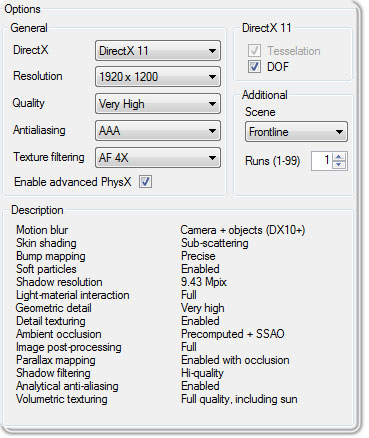 |

Lost Planet 2

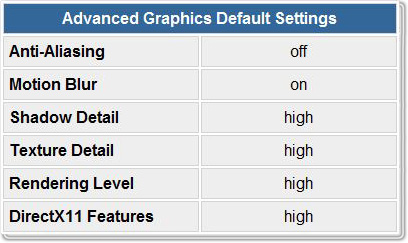
Lost Planet 2 is an intense game with fierce and fast battles. It is pure action, and makes excellent use of the DirectX11 features. As observed with the previous gaming benchmarks, a 14% increase is solid across both resolutions.
Unigine Heaven 2.1
In Unigine Heaven, the MSI 560 has a modest increase over the Palit 460 of 18% in both resolutions. Unigine Heaven is an excellent benchmark for stressing such DirectX11 elements as occlusion (atmospheric light), refraction, and volumetric fog. Overclocking the card had little effect.
FLuidmark (Physx)
PhysX FluidMark is a physics benchmark based on the NVIDIA PhysX Engine. This benchmark performs a fluid simulation using the SPH (Smoothed Particle Hydrodynamics) algorithm to increase the realism of the fluid. FluidMark supports GPU PhysX (NVIDIA GeForce 8+ only) as well as multi-core CPU PhysX. This benchmark exploits OpenGL for graphics acceleration and shows an approximate average of a whopping 30% difference between the cards.
3DMark Vantage
This is where those extra 48 CUDA Cores really show their worth, breaking the 20,000 mark effortlessly (at a 17% difference). To address the middle- to high-end users concerning this benchmark, subjective results have led to the opinion that any card over the 16,000 mark is very well suited in this year’s — and even next year’s — gaming environment. Anything higher is just icing on the cake and will ensure users can crank the eye candy all the way up.
3DMArk 11
This is a very heavy benchmark test even, at the performance setting. The solid 17% increase concurs with the results of 3DMark Vantage and Unigine Heaven.
Even under all the benchmarking the Twin Frozr could not be heard over the CPU fan. Very Impressive. This was even more quiet than the Palit 460 fan (which was barely audible above all other fans). Even more interesting was the temperature the MSI card was running under full load, (and didn’t change during overclocking), check out the info below:
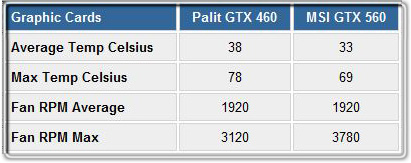

The card was nine degrees cooler under full load (that was run about 4 hours). Most users will not come even close to full load under normal operating conditions, so this card will be hard to beat on the heat front. Keep in mind, that the MSI card is also sipping 20 more watts of power at this time.
Conclusion
The performance difference between the MSI 560Ti and the Palit 460 has a spread of 15-30% difference across all benchmarks. With the overclocking in mind, another 5% can be added to that. Performance in games was admirable, and totally playable at full resolution (1920×1200). The MSRP of the MSI 560 is $259.99, which is only ten dollars more than the reference card. The card itself is built like a tank, and the metal shield is of high quality. The best feature is the Twin Frozr II heatsink system, which keeps everything at a cool 69 Celsius under full load. Overall, the MSI 560Ti is an almost perfect product, and deserves serious consideration from buyers looking for a reasonable upgrade.
| MSI GTX 560 TI Twin Frozr II OC | ||||||||||||||||||
Summary: The MSI GTX 560Ti Twin Frozr II / OC is not only an excellent upgrade option due to its performance, but considering its price, the card has the Best Bang for the Buck. This is a near perfect card, and with a score of 9.5/10, the MSI 560 Ti earns the Bjorn3D Golden Bear Award. |
||||||||||||||||||
 Bjorn3D.com Bjorn3d.com – Satisfying Your Daily Tech Cravings Since 1996
Bjorn3D.com Bjorn3d.com – Satisfying Your Daily Tech Cravings Since 1996


